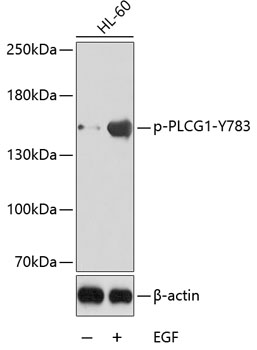Immunology Antibodies 3
Anti-Phospho-PLCG1-Y783 Antibody (CABP0164)
- SKU:
- CABP0164
- Product Type:
- Antibody
- Applications:
- WB
- Reactivity:
- Human
- Reactivity:
- Mouse
- Reactivity:
- Rat
- Host Species:
- Rabbit
- Isotype:
- IgG
- Research Area:
- Immunology
Description
| Antibody Name: | Anti-Phospho-PLCG1-Y783 Antibody |
| Antibody SKU: | CABP0164 |
| Antibody Size: | 20uL, 50uL, 100uL |
| Application: | WB |
| Reactivity: | Human, Mouse |
| Host Species: | Rabbit |
| Immunogen: | A phospho specific peptide corresponding to residues surrounding Y783 of human PLCG1 |
| Application: | WB |
| Recommended Dilution: | WB 1:500 - 1:2000 |
| Reactivity: | Human, Mouse |
| Positive Samples: | HL-60 |
| Immunogen: | A phospho specific peptide corresponding to residues surrounding Y783 of human PLCG1 |
| Purification Method: | Affinity purification |
| Storage Buffer: | Store at -20°C. Avoid freeze / thaw cycles. Buffer: PBS with 0.02% sodium azide, 50% glycerol, pH7.3. |
| Isotype: | IgG |
| Sequence: | Email for sequence |
| Gene ID: | 5335 |
| Uniprot: | P19174 |
| Cellular Location: | Cell projection, lamellipodium, ruffle |
| Calculated MW: | 148kDa |
| Observed MW: | 149kDa |
| Synonyms: | PLCG1, NCKAP3, PLC-II, PLC1, PLC148, PLCgamma1 |
| Background: | The protein encoded by this gene catalyzes the formation of inositol 1, 4, 5-trisphosphate and diacylglycerol from phosphatidylinositol 4, 5-bisphosphate. This reaction uses calcium as a cofactor and plays an important role in the intracellular transduction of receptor-mediated tyrosine kinase activators. For example, when activated by SRC, the encoded protein causes the Ras guanine nucleotide exchange factor RasGRP1 to translocate to the Golgi, where it activates Ras. Also, this protein has been shown to be a major substrate for heparin-binding growth factor 1 (acidic fibroblast growth factor)-activated tyrosine kinase. Two transcript variants encoding different isoforms have been found for this gene. |
| UniProt Protein Function: | PLCG1: a calcium dependent phosphatidylinositol-specific phospholipase C. The activated enzyme produces the second messenger molecules diacylglycerol and inositol 1,4,5-trisphosphate. Phosphorylated and activated by tyrosine kinases in response to signaling through a variety of growth factor receptors and immune system receptors. |
| UniProt Protein Details: | Protein type:Motility/polarity/chemotaxis; Phospholipase; Carbohydrate Metabolism - inositol phosphate; EC 3.1.4.11 Chromosomal Location of Human Ortholog: 20q12-q13.1 Cellular Component: cell projection; cytoplasm; cytosol; intercellular junction; lamellipodium; plasma membrane; ruffle; signalosome Molecular Function:calcium ion binding; glutamate receptor binding; neurotrophin TRKA receptor binding; phosphoinositide phospholipase C activity; phospholipase C activity; protein binding; protein kinase binding; receptor signaling protein activity; receptor tyrosine kinase binding Biological Process: activation of MAPKK activity; axon guidance; blood coagulation; calcium-mediated signaling; cell migration; cytokine and chemokine mediated signaling pathway; epidermal growth factor receptor signaling pathway; fibroblast growth factor receptor signaling pathway; in utero embryonic development; innate immune response; inositol phosphate metabolic process; leukocyte migration; nerve growth factor receptor signaling pathway; phospholipase C activation; phospholipid catabolic process; positive regulation of angiogenesis; positive regulation of blood vessel endothelial cell migration; positive regulation of release of sequestered calcium ion into cytosol; signal transduction; T cell receptor signaling pathway; vascular endothelial growth factor receptor signaling pathway; viral reproduction |
| NCBI Summary: | The protein encoded by this gene catalyzes the formation of inositol 1,4,5-trisphosphate and diacylglycerol from phosphatidylinositol 4,5-bisphosphate. This reaction uses calcium as a cofactor and plays an important role in the intracellular transduction of receptor-mediated tyrosine kinase activators. For example, when activated by SRC, the encoded protein causes the Ras guanine nucleotide exchange factor RasGRP1 to translocate to the Golgi, where it activates Ras. Also, this protein has been shown to be a major substrate for heparin-binding growth factor 1 (acidic fibroblast growth factor)-activated tyrosine kinase. Two transcript variants encoding different isoforms have been found for this gene. [provided by RefSeq, Jul 2008] |
| UniProt Code: | P19174 |
| NCBI GenInfo Identifier: | 130225 |
| NCBI Gene ID: | 5335 |
| NCBI Accession: | P19174.1 |
| UniProt Secondary Accession: | P19174,Q2V575, B7ZLY7, B9EGH4, E1P5W4, |
| UniProt Related Accession: | P19174 |
| Molecular Weight: | 148,660 Da |
| NCBI Full Name: | 1-phosphatidylinositol 4,5-bisphosphate phosphodiesterase gamma-1 |
| NCBI Synonym Full Names: | phospholipase C gamma 1 |
| NCBI Official Symbol: | PLCG1 |
| NCBI Official Synonym Symbols: | PLC1; NCKAP3; PLC-II; PLC148; PLCgamma1 |
| NCBI Protein Information: | 1-phosphatidylinositol 4,5-bisphosphate phosphodiesterase gamma-1 |
| UniProt Protein Name: | 1-phosphatidylinositol 4,5-bisphosphate phosphodiesterase gamma-1 |
| UniProt Synonym Protein Names: | PLC-148; Phosphoinositide phospholipase C-gamma-1; Phospholipase C-II; PLC-II; Phospholipase C-gamma-1; PLC-gamma-1 |
| Protein Family: | 1-phosphatidylinositol 4,5-bisphosphate phosphodiesterase |
| UniProt Gene Name: | PLCG1 |
| UniProt Entry Name: | PLCG1_HUMAN |







